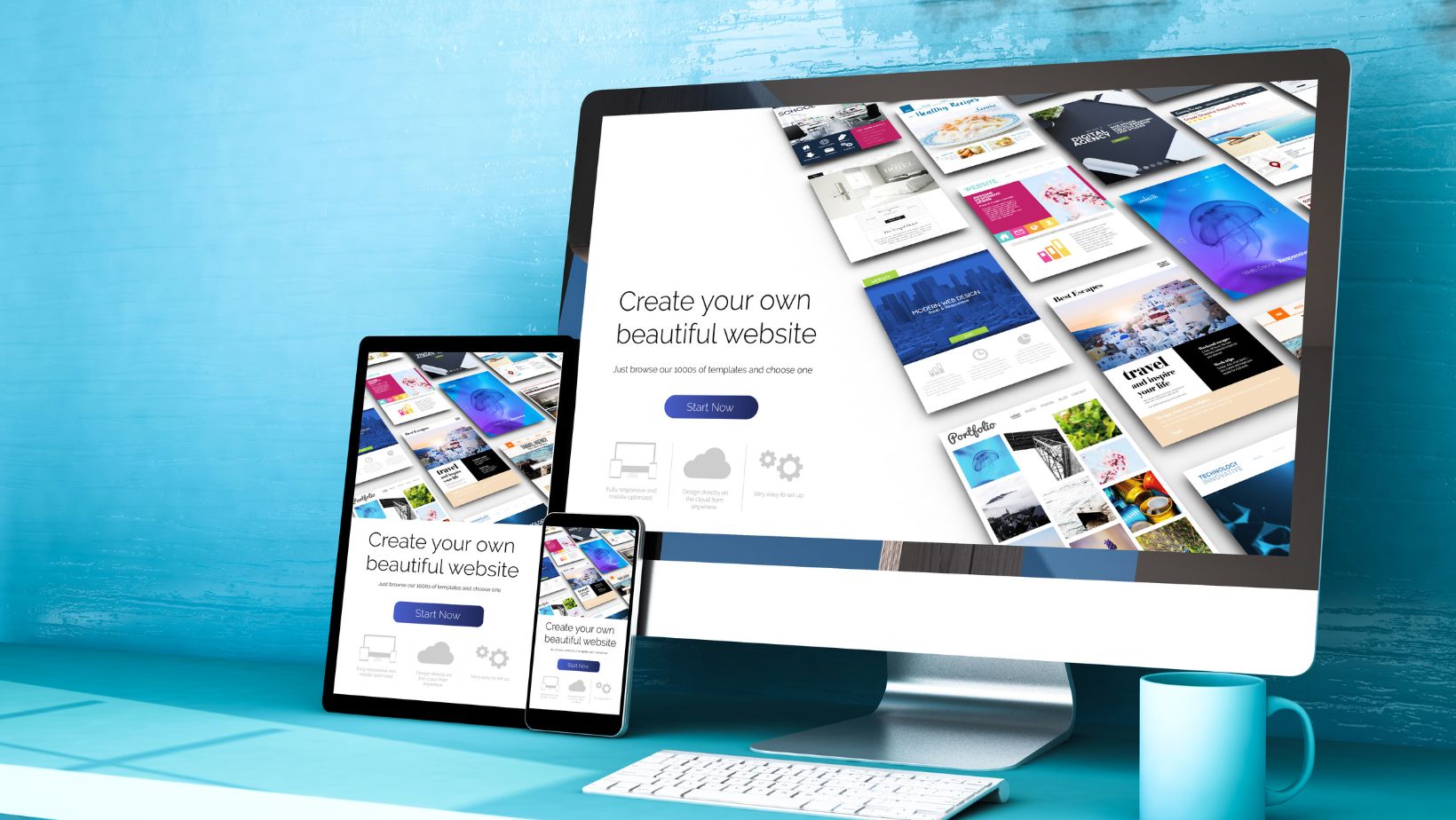How to Design a Corporate Website That Enhances Your Brand Identity

In today’s digital age, a corporate website serves as the cornerstone of a company’s online presence. It’s not just a platform for information; it’s a powerful tool to communicate brand identity and values. A well-designed website can significantly enhance a brand’s image, making it crucial for businesses to invest time and resources into thoughtful design.
Creating a corporate website that truly reflects a brand’s identity involves more than just aesthetic appeal. It requires a deep understanding of the brand’s core values, target audience, and market positioning. By aligning design elements with these factors, businesses can build a cohesive and compelling online presence that resonates with visitors and strengthens brand loyalty.
Understanding Brand Identity
Brand identity consists of elements that define how a business wants to be perceived. It incorporates logos, design, colors, and messaging to distinguish the brand in the marketplace. When designing a corporate website, these elements must remain consistent to create a cohesive brand story.
Core Values and Vision
Accurate representation of core values is essential. A corporate website should clearly communicate the company’s mission and vision, aligning them with visual elements and content. This helps users quickly understand what the brand stands for.
Target Audience
Identifying the target audience shapes the website’s overall design. If a business targets professionals, the corporate website design may use a sleek, modern look. Conversely, a company focusing on a younger audience might opt for more vibrant, dynamic visuals. Understanding the audience informs the content, tone, and layout, enhancing user engagement.
Market Positioning
Positioning defines a brand’s competitive stance. The website must reflect this through strategic content and visuals. For example, luxury brands often use high-quality images and minimalist design to convey exclusivity and sophistication. Similarly, a tech company might use interactive elements to showcase innovation.
Visual Elements
Visual elements like logos, color schemes, and typography should align with the brand’s identity. Consistent use of these elements reinforces recognition and builds trust. A logo placed prominently on the homepage, along with a uniform color palette and font use throughout, ensures a professional and reliable image.
Tone and Messaging
The tone of content must align with the overall brand messaging. A corporate website for a financial firm might use formal, precise language. On the other hand, a fashion brand could adopt a more conversational tone. Consistent messaging across all pages presents a unified brand voice.
Integrating brand identity into corporate website design development creates a cohesive and compelling online presence.
Key Elements of a Corporate Website
Designing a corporate website that boosts brand identity involves several key elements that need careful consideration.
Visual Design
Visual design directly impacts corporate website design development. A professional, clean layout builds credibility and reflects the brand’s ethos. Use brand colors and fonts consistently to reinforce identity. Logos should be prominently displayed. Implement high-quality images and graphics that convey the company’s values. Ensure the design is responsive, providing an optimal experience across devices.
Content Strategy
A strong content strategy ensures that the website’s information aligns with brand messaging. Create clear, concise content that speaks directly to the target audience. Use headlines to highlight key information and make navigation easy. Incorporate keywords for SEO to enhance visibility. Share regular updates, such as blog posts, articles, and news, to keep the site dynamic and engaging. Customer testimonials and case studies add authenticity and build trust.
User Experience
User experience (UX) is crucial in corporate website design development. An intuitive navigation system should enable users to find information easily. Fast loading times improve user satisfaction and retention. Use clear calls-to-action to guide visitors towards desired actions. Integrate contact forms, live chat, and other interactive elements to enhance engagement. Regularly test the site for usability issues and make necessary adjustments to meet user expectations.
By focusing on these key elements—visual design, content strategy, and user experience—a corporate website can effectively enhance brand identity and provide a compelling online presence.
Steps to Enhance Brand Identity
Designing a corporate website involves several steps to ensure it enhances brand identity effectively.
Consistent Branding
Ensure every element on the site aligns with the overall brand identity. Use the company’s logo, tagline, and mission statement prominently. Maintain uniformity in design, from headers and footers to the layout of different pages. This consistency helps create a seamless user experience and reinforces the brand’s identity across all touchpoints.
Strategic Use of Colors and Typography
Colors and typography significantly impact how a brand is perceived. Utilize a color palette that reflects the brand’s personality and market positioning. Each color should complement the others to create a cohesive look. Similarly, choose fonts that resonate with the brand’s tone, whether it’s professional, casual, or innovative. Proper use of colors and fonts enhances readability and attracts visitor attention, contributing to a memorable user experience.
Incorporating Brand Stories
Incorporate brand stories to humanize the company and connect with the audience on a deeper level. Use case studies, customer testimonials, and behind-the-scenes content to showcase the brand’s journey, achievements, and values. Authentic stories build trust and foster emotional engagement, making the brand more relatable and memorable.
Best Practices in Corporate Website Design
Implementing best practices ensures a corporate website effectively enhances brand identity. This section delves into key elements that contribute to successful corporate website design and development.
Responsive Design
Ensuring a website is responsive means it looks and functions well on all devices. Users expect seamless experiences whether they’re on a desktop, tablet, or smartphone. Responsive design involves fluid grids, flexible images, and media queries. For instance, a corporate website must adapt to different screen sizes, maintaining usability and appearance. High-priority content, such as contact information and calls-to-action, should remain easily accessible across all devices.
SEO Optimization
SEO optimization is crucial for improving a corporate website’s visibility in search engines. Integrating relevant keywords, optimizing meta tags, and ensuring quality backlinks contributes to higher rankings. Use SEO tools like Google Analytics and Search Console to monitor performance. An optimized website increases organic traffic, making it easier for potential clients to find the brand. Implementing structured data helps search engines understand the site’s content better, enhancing visibility and click-through rates.
Security and Compliance
Security and compliance form the backbone of a trustworthy corporate website. SSL certificates ensure data encryption, instilling confidence in users. Incorporating regular security audits helps identify and mitigate potential vulnerabilities. Compliance with regulations such as GDPR or CCPA is essential, especially for companies handling sensitive user data. Displaying privacy policies and obtaining user consent for cookies and data collection builds transparency and trust.
By focusing on these practices, a corporate website can successfully enhance brand identity and create a reliable online presence.
Case Studies
Examining successful case studies provides valuable insights into how corporate website design enhances brand identity. By analyzing real-world examples, businesses can identify effective strategies and avoid common pitfalls.
Successful Examples
Apple Inc.
Apple’s corporate website is a masterclass in minimalistic design aligned with its brand identity. The site uses a clean layout, ample white space, and high-resolution product images. The consistent use of the Apple logo, typography, and color palette strengthens brand recognition. User-friendly navigation ensures visitors find information effortlessly.
Nike
Nike’s website effectively integrates bold visuals, engaging storytelling, and interactive elements to promote its brand ethos. The use of high-impact images and videos, along with a distinctive black-and-white color scheme, reflects Nike’s dynamic and athletic identity. Customer testimonials and case studies featuring athletes further humanize the brand, fostering strong emotional connections.
Coca-Cola
Coca-Cola’s site emphasizes its brand heritage and commitment to sustainability. The website’s design incorporates the iconic red-and-white color scheme, the classic logo, and engaging content about brand history and sustainability initiatives. The seamless user experience, combined with strategically placed call-to-action buttons, enhances user engagement and brand loyalty.
Lessons Learned
Consistency is Key
Successful brands showcase the importance of maintaining consistency across all design elements. Colors, fonts, and logos should remain uniform throughout the website to reinforce brand identity.
User Experience Matters
An intuitive, user-friendly website enhances visitor engagement. Navigation should be straightforward, with clear menus and quick load times to keep users on the site longer.
Storytelling Enhances Connection
Incorporating brand stories, customer testimonials, and case studies makes the website more relatable. These elements build emotional connections and humanize the brand.
Visual Appeal Attracts
High-quality visuals significantly impact user perception. Professional images and videos, combined with a cohesive color scheme, make the website more attractive and engaging.
SEO and Content Strategy
SEO-optimized content ensures higher visibility on search engines. Using relevant keywords and consistent updates keeps the website dynamic and ranks it higher. Engaging content aligned with brand messaging contributes to a strong online presence.
By drawing lessons from successful examples, businesses can better utilize corporate website design and development to enhance brand identity.
Conclusion
A well-designed corporate website is more than just an online presence; it’s a powerful tool for enhancing brand identity. By integrating core values, consistent visual elements, and strategic content, companies can create a cohesive and engaging online experience. Understanding the target audience and market positioning ensures the website resonates with visitors, fostering brand loyalty.
Incorporating responsive design, SEO optimization, and robust security measures further solidifies the website’s credibility and reach. Learning from successful brands like Apple and Nike underscores the importance of consistency, user experience, and storytelling. Ultimately, a thoughtfully designed corporate website not only communicates a brand’s identity but also strengthens its market position and builds lasting connections with its audience.
-
Personal Finance1 year ago
How Do I Find My UCAS ID Number?
-
Success6 years ago
Consistency: The Key Ingredient to Success
-
Personal Finance1 year ago
What Does Conditionally Approved Mean For An Apartment?
-
Motivation3 years ago
How To Become a More Organized Person?
-
Others5 years ago
Work Health and Safety: 8 Reasons to Maintain a Clutter-free Office
-
Entrepreneurs4 years ago
Why Diversity is Key in Business Marketing
-
HK Pools1 year ago
The HK Pools Forum Comunity Jos Markotop 2D Warna Kuning – A Great Way to Stay Connected
-
Sport2 years ago
What Makes Soccer Betting So Great?





























